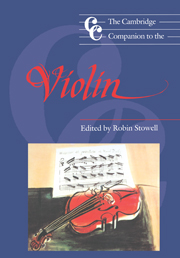Book contents
- Frontmatter
- 1 The violin and bow – origins and development
- 2 The physics of the violin
- 3 The violinists of the Baroque and Classical periods
- 4 The nineteenth-century bravura tradition
- 5 The twentieth century
- 6 The fundamentals of violin playing and teaching
- 7 Technique and performing practice
- 8 Aspects of contemporary technique (with comments about Cage, Feldman, Scelsi and Babbitt)
- 9 The concerto
- 10 The sonata
- 11 Other solo repertory
- 12 The violin as ensemble instrument
- 13 The pedagogical literature
- 14 The violin – instrument of four continents
- 15 The violin in jazz
- Appendix Principal violin treatises
- Glossary of technical terms
- Notes
- Select bibliography
- Index
12 - The violin as ensemble instrument
Published online by Cambridge University Press: 28 September 2011
- Frontmatter
- 1 The violin and bow – origins and development
- 2 The physics of the violin
- 3 The violinists of the Baroque and Classical periods
- 4 The nineteenth-century bravura tradition
- 5 The twentieth century
- 6 The fundamentals of violin playing and teaching
- 7 Technique and performing practice
- 8 Aspects of contemporary technique (with comments about Cage, Feldman, Scelsi and Babbitt)
- 9 The concerto
- 10 The sonata
- 11 Other solo repertory
- 12 The violin as ensemble instrument
- 13 The pedagogical literature
- 14 The violin – instrument of four continents
- 15 The violin in jazz
- Appendix Principal violin treatises
- Glossary of technical terms
- Notes
- Select bibliography
- Index
Summary
During its history, the violin has been associated with an abundance of other instruments, not to mention its particularly close relationship with the human voice, to which it has often been compared. To chronicle this would be a formidable task, but fortunately, over a number of centuries, musical taste has favoured a quite limited range of specific groupings which quickly acquired the status of ‘genre’. A Haydn string quartet suggests not just an instrumental combination but a specific mode of treatment, and it is such characteristic forms rather than any ad hoc instrumentation which must demand the closest attention. For the present purposes an ensemble is defined rather arbitrarily as any group of two or more instrumentalists, but excluding compositions for violin and keyboard, the main concern being that repertory categorised today by the equally arbitrary term ‘chamber music’. The New Grove Dictionary defines this as ‘music for small ensembles of solo instruments, written for performance under domestic circumstances’, but this is especially inadequate for the seventeenth century, when small ensemble music need not have been performed in ‘chambers’, while ‘chamber ensembles’ may have been used as ‘orchestras’ in public theatres or churches. Some flexibility has therefore seemed advisable, at least for the first two centuries of this development.
- Type
- Chapter
- Information
- The Cambridge Companion to the Violin , pp. 210 - 223Publisher: Cambridge University PressPrint publication year: 1992

